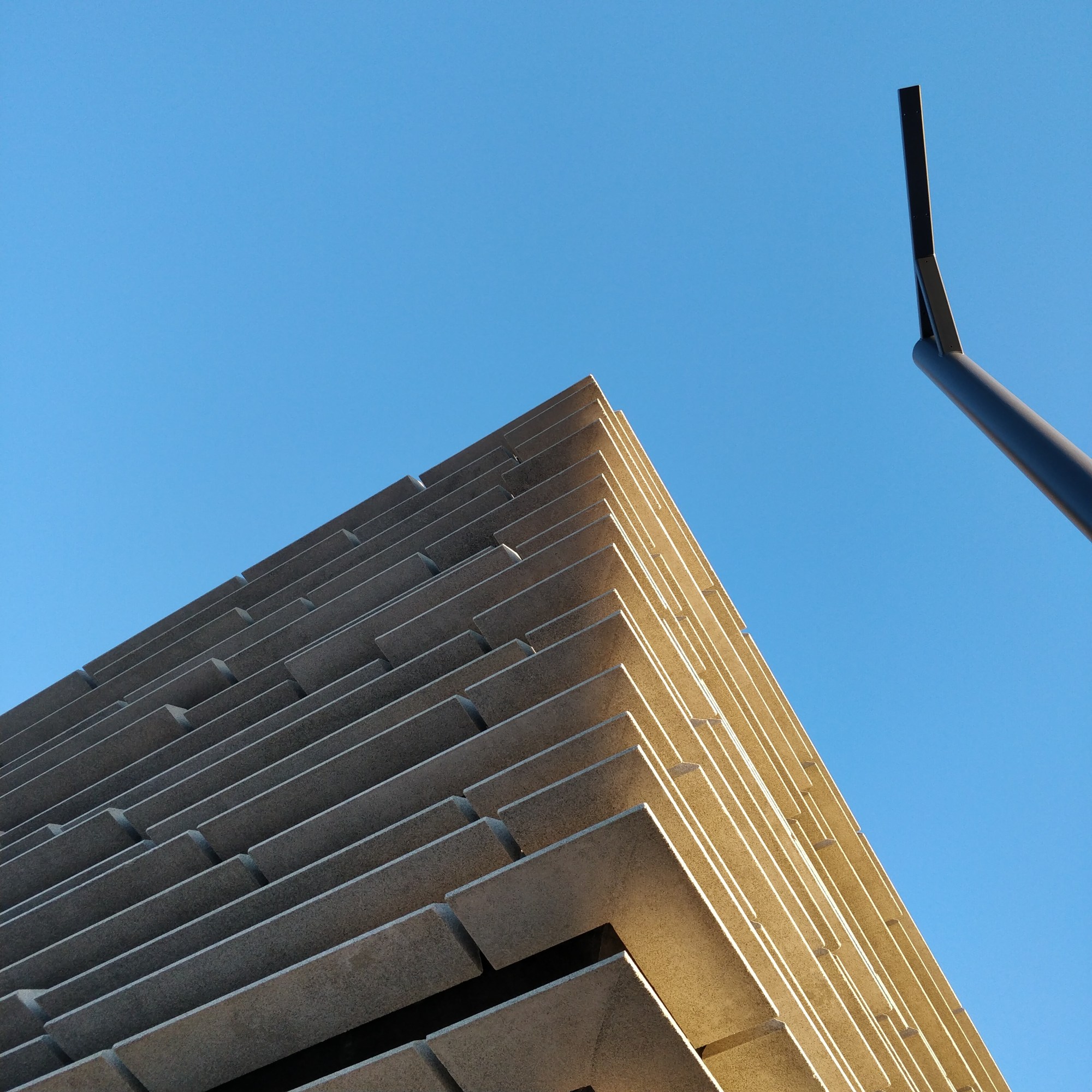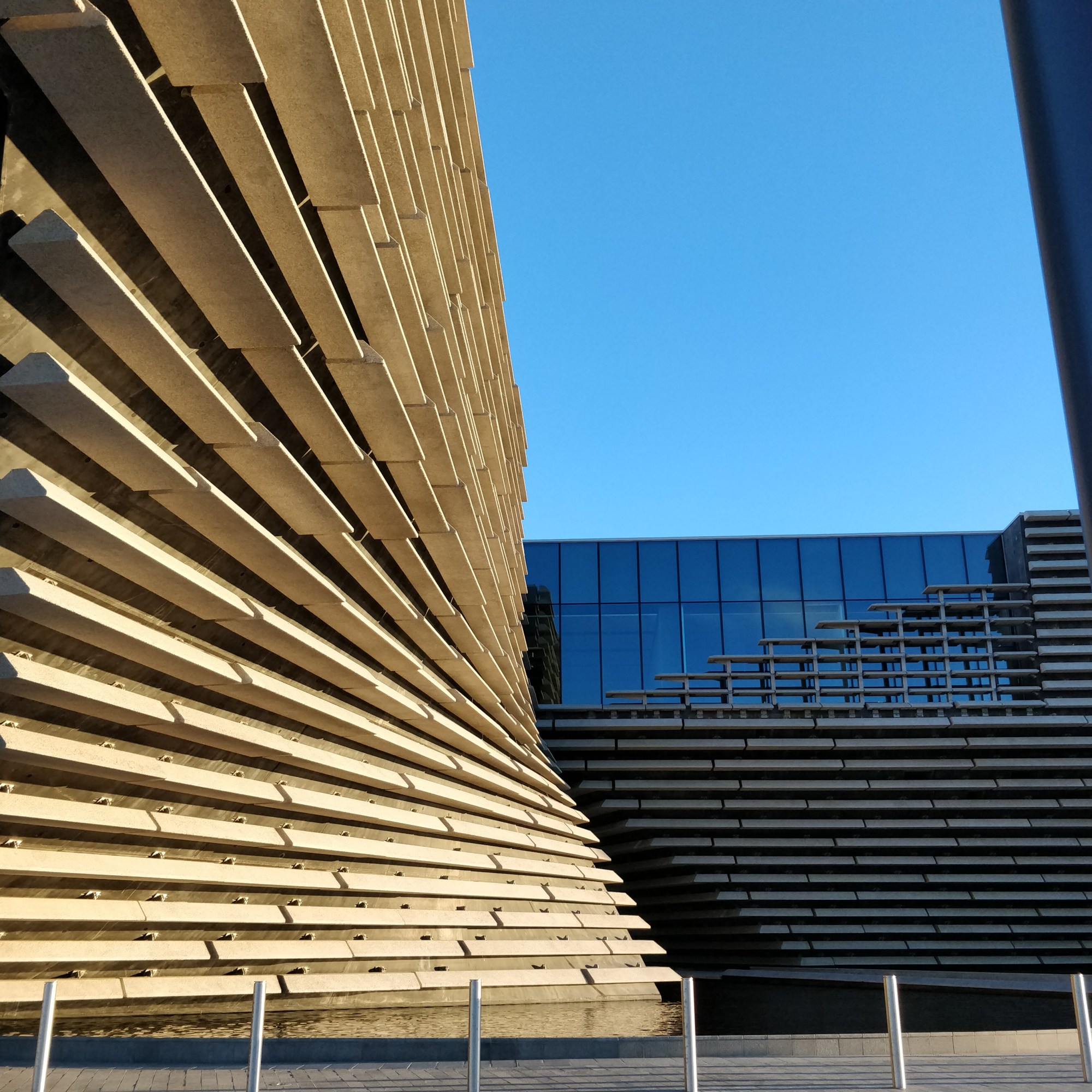For both familiar and unfamiliar visitors arriving up the north-east coast by train, Dundee feels like what it is: a city in a state of flux. For the last half-decade and more, the portion of waterfront that houses the station has been a densely knotted building site. An almost-finished home to a billion pound redevelopment, encompassing gleaming new hotels, retail units and a mercifully simplified road structure, replacing the decayed concrete miserablism and congestion that made Scotland’s fourth city a national byword for grimness and urban neglect.
At the centre of all this costly noise and activity arrives the V&A Dundee: Scotland’s first dedicated design museum, brought to life by Japanese starchitects practice Kengo Kuma & Associates at the price of almost a decade and £80m. Effort has been made to ensure that it is a Scottish design museum and not just a branch office of the London original; the programming isn’t a greatest hits roadshow, though exhibitions from the capital will make their way up. It’s the Scottish Design Galleries that are to serve as the heart, celebrating the rich, multilayered history and contemporary achievements of the country’s design heritage, from engineering feats like the Forth Road Bridge, to the display of the original Charles Rennie Mackintosh Oak Room for the first time since its salvage 50 years ago. As lead curator Joanna Norman has put it, the hope is to present a “fascinating and relatively unknown story to the world”.
And though costs and deadlines might have spiralled, the finished building itself is an impressive monument to its spectacular setting on the banks of the River Tay. On approach, it seems to catch competing angles of light in its dense layers, and though grand in scale, it doesn’t obnoxiously swamp its riverside surroundings.
Yet the desired effect is something deeper than just expensive prettification. It’s the frontispiece to a bright new imagined future for a city ready to climb clear of a troubled recent history. From 19th century manufacturing goliath to, as the great Scottish architecture critic and Dundee advocate Charles McKean wrote during the fallow 1970s and 80s: “an invisible town, unloved and even unmentioned in Scottish history books”.
When it opens its doors in September of this year, there will be much talk of triumph and rebirth and the hope that the opening of a prestigious international arts institution can ignite a wider economic boost for a city with the lowest employment rate in the UK. There might well be even more mention of Dundee in lists of international “hot destinations”, following the lead of a Wall Street Journal feature last year that, slightly optimistically, labelled it “Scotland’s coolest city”. There will certainly be a few notes of caution, too. Dundee is far too over familiar with false dawns and disappointments to fully abandon itself to checkless optimism.
As Mckean wrote, “by the 60s and 70s most of Dundee’s (Medieval and Victorian) architectural heritage made way for car parks, shopping centres and walkways, turning a once beautiful city into the eyesore many see it as today”. In his view these decisions undertaken by Dundee’s City Fathers amounted to more than just urban vandalism: they “obliterated much of its past”.
It’s a conclusion shared by many, and if that was a revolution characterised by arrogance and blundering ineptitude then there are promising signs this time around that lessons have been learned — and more than just a tokenistic fidelity paid to history. Although perhaps that’s the wrong way of putting it. This isn’t a top down imposition. It’s not a case of the V&A being superimposed on to a barren landscape, or tacked onto a city without its own rich pedigree. Dundee might fly under the national radar, but that doesn’t mean it’s a cultural backwater. Indeed as anyone with a cursory knowledge of the city knows, this is a place that continually punches far above its weight class when it comes to creativity.
Yet that isn’t quite the same thing as cultural capital. In terms of size and wider renown, it lags behind Edinburgh and Glasgow as both a destination and centre point for the arts in Scotland. Hardly shocking for a city of just 120,000 people. What’s much more unusual is what it does have. Two well regarded universities (Abertay is a leader in Computer Games Technology, fittingly for the city that birthed Rockstar Games), the internationally well regarded art school Duncan of Jordanstone, status as the UK’s only UNESCO World City of Design, a generously funded contemporary arts space in the DCA, Scotland’s only repertory theatre The Dundee Rep, a thriving literary festival, a myriad of independent grassroots arts charities and collectives and one of the finest nightclubs in the country.

It’s hardly the fish grey purgatory that cliche would have it. And certainly not bad going for a city with only a marginally larger population than Rochdale. It was only by the smallest of majorities that it lost out to Hull in the running for European City of Culture 2017, a disappointment that denied Dundee the potential for the same bounce Glasgow experienced when it received the award in 1990.
Although prestigious prizes and blue chip arts institutions are lovely things, they’re an effect, not the cause, of what’s curated the cautious optimism in Dundee today. Tracey Stewart is a designer and academic who’s been been based in the city for the past 11 years, she tells me as we meet at The Art Bar, an underground spot tucked in the shadow of the art school on the student heavy Perth Road. Her own studio is based at WASPS (Workshop and Artist Studio Provisions Scotland), a cross-country network of artist spaces, spanning 18 sites, from the Scottish borders to the Shetland Islands.
Though, as she points out, “most people don’t realise that it was started by two artists in Dundee forty years ago”. It speaks to a wider point about the city’s history, one marked by this kind of self reliance and quiet emphasis on innovation. A history spanning “from the invention of the adhesive post stamp and building the longest rail bridge in Europe [in the 19th century], to the contemporary plethora of musical, artistic and design talent today”.
Despite the richness of the past, and all the activity and sense of community today, wider structural problems remain. Issues of representation and long term strategic investment. Big banner cultural organisations aren’t always renowned for their deftness in involving communities outside of their immediate comfort zone of regular middle class exhibition attendees. Positive noises are often made about inclusion and provision of access, before dissipating in a cloud of goodwill and incomprehension. But there’s a sense that the V&A are planning to do things differently, with provision made for “dynamic learning spaces to accommodate visitors of all ages and backgrounds to learn from and participate in design creativity” and the running of workshops and outreach programmes within the city.
It’s part of a general feeling that this investment in Dundee could prove of lasting consequence. Andy Slater is part of the committee-run arts space Generator, and mentions looking forward to the possibility of collaboration with both themselves and “all local cultural organisations to draw visitors further into the city”.
And while increased tourism is a laudable goal, it’s another similar side effect that could prove more lastingly significant. As with ‘provincial’ cities all over the country, Dundee has an issue with retention of its creative classes, as young talent move to bigger hubs for work and opportunity. Glasgow proves to Dundee what London proves from Glasgow. What the spike in investment provided by the V&A could catalyse is a stop to that flow and an encouragement for setting down deeper ties to the city, rather than feeling obliged to move on by necessity.
Dundee native Mark Usher, landlord of The George Orwell pub is a case in point. Though the twin events of Acid House and the high water mark of rave culture made for an exciting youth, he found that by the mid 90’s “things were getting a bit stale” with opportunities limited. So he headed for London and spent almost 18 years in the capital, running and owning a variety of pubs, bars and nightclubs, including a five year stint managing Fabric. Yet in 2013 he decided to make the move back north to open his own place in Dundee and found his home city a changed place. Particularly “how much more international and cosmopolitan it had — and has — become even in the 4-5 years since my return. It seems much more receptive to new ideas now, and people are much more upbeat”.
There is an “air of confidence in the city”, he notes. And it isn’t just a confidence spawned from the arrival of a behemoth museum and the benefits it might well bring. As Mark says, it’s long past the stage of what “might” change for the better in “the fourth city”. For Dundee, change is something present tense: “It’s happening right here, right now.”
